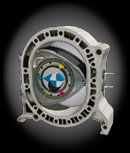 |
|


The Wankel rotary engine was first conceived by Dr. Felix Wankel, who worked in partnership with a German company called NSU to develop it into a production engine in the mid-to-late 1950s. While his preferred "pure" rotary engine proved unpractical, the planetary motion version eventually emerged as the basis for all Wankel rotary engines developed since that time. NSU was the early pioneer and, jointly with Dr. Wankel, the patent holder. NSU created the first production version of the engine and, not surprisingly, was the first build a vehicle around it, the 1963 NSU Prinz. At the same time, NSU sold licenses to other manufacturers to develop their own versions independently. Most major vehicle manufacturers bought a license and pursued programs of varying extent. Major players like GM and Mercedes committed the most resources and seemed to be making the greatest strides towards volume production but, for various reasons, it was a small Japanese company named Toyo Kogyo (later renamed Mazda, after its most successful division) that became the standard bearer as others dropped out. In practice, you can basically separate rotary engines into two categories: Mazda and everyone else. This guide will focus on Mazda production and race engines, but there will be some information on non-Mazda experimental and production engines, as well. If you want to learn more about the history of the engines, please pick up a copy of the John Matras book, titled Sports Car Color History: Mazda RX-7.
MAZDA
Mazda production engines follow a fairly simple numbering system. The numbers roughly indicate rated displacement in liters times ten (13B = 1.308L, or 1308cc), though sometimes a bit optimistic (12A = 1146cc), and the letter indicates a significant design revision. The first Mazda rotary cars were powered by 10A engines, while subsequent rotaries were either 12As or 13Bs (of numerous varieties). Outside the US, Mazda even produced cars around the 3-rotor 20B, in twin turbo form. Virtually all Mazda rotaries, from the 10A to the 20B, share the same internal dimensions save chamber width. For 10As, the chamber width was 60mm, resulting in 982cc (0.982L) displacement. 12As had a 70mm wide chamber, giving them 1146cc. 13Bs and 20Bs both have 80mm wide chambers, producing 1308cc and 1962cc, respectively.